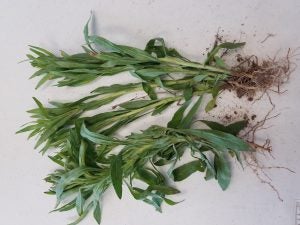The Ag PhD Crop Scouting Reports are supplied by contributors to Hefty Seed Co., based in Baltic, South Dakota. Find more online at www.agphd.com and www.heftyseed.com.
ILLINOIS
Georgetown, IL
If you are a grower with Xtend soybeans and have volunteer corn, remember to choose a volunteer corn killer that is labeled right now to tankmix with XtendiMax. Growers who are choosing one of the clethodim products are upping the normal 6 oz/acre rate and instead using 9 oz/acre to offset any potential antagonism from the broadleaf killer in this tankmix. — Tyler Smith
Princeton, IL
I am seeing visual differences between almost all fertility trials. It is the first step in seeing what works best for your farm. I am getting excited to see what the yield monitor says. — Nate Ihnen
A lot of grass and weeds are starting to appear in driveways and barnyards. 8-16 ounces of Esplanade spiked with 3 oz Powermax per gallon of water will treat 1,000 square feet. This will provide burndown and several months residual. Works better than a flamethrower. — Mike Denton
IOWA
Rockwell, IA
Soybean fields with pH pockets in the 7.5 to 8.0 range will have large portions of yellowing from IDC or iron deficiency chlorosis soon. Insufficient drainage tile will help long-term and if you are low in sulfur that can help lower pH as well. For this year’s crop, Soygreen is a chelated iron treatment that we have seen good results with for many years now. Ideally, use 1 gallon in-furrow at seeding. Plan B is post applying a half-gallon and another half-gallon again approximately 10 days later. Plan for both post trips or none – both applications are a must for ROI. — Paul Helland
Sheldon, IA
The summer heat usually brings in some big storms that can carry damaging winds and hail. If your crop happens to get hit with this weather, a fungicide application shortly after would be a great option. The damage to the plant will open it up for diseases that the fungicide will help to prevent and move forward from. — Adam Sauer
KANSAS
Garden City, KS
As wheat harvest nears and combines are prepared, take the time to make sure you can take yield data. Every crop’s needs are different, and a yield map on wheat is a great place to start on next year’s fertility program. Variations in yield maps can clue you in on why certain areas are having problems. Is it a pH issue? Is it N, P, K? Perhaps it is a micronutrient issue. Yield maps can help you know where to sample, and often, can help you find a solution. — Chris Lobmeyer
MINNESOTA
Fairmont, MN
A lot of guys are starting to finish up on corn spraying and switching over to soybeans. Using a three-step rinse tank clean out is very important before switching crops. A very effective tank cleaner is Erase at 2 qt per 100 gallons cleaning water. — Sam Geistfeld
LeRoy, MN
Some of the growers in our territory got hit with some hail. Make sure you go and figure out what your stands look like. Soybeans can handle a fair amount of leaf damage before hurting yield, but if the stem gets cut or injured below the cotyledons, that’s when you can run into problems. If the leaves are just shredded a bit, there shouldn’t be too many issues. — Grant Lunning
Olivia, MN
Soybean spraying is either going on or about to get started in the area. If you are using a Flexstar type product, remember the rotation restriction to corn is 10 months, meaning if you sprayed today, June 11, 2018, you would be safe to plant corn April 11, 2019. — John Scheibel
If you have bugs in your house, lawn, or barn, consider spraying Tempo. Tempo is great for controlling mosquitos, spiders, flies, and many other pests. Most importantly though, it is a safe product so children and pets can re-enter the treated area once the product has dried. — Tony Hagen
Thief River Falls, MN
I have been seeing some sulfur deficiency symptoms in corn around the area. Tissue sampling is one way to check to see if sulfur is actually the cause. If crop is lacking sulfur, adding AMS with urea or ATS to your 28% when top or side-dressing is a great way to assess the issue and make sure your crop isn’t lacking any nutrients. — Jordan Swanson
Winthrop, MN
If you are looking for a product to stop thistles in your pea crops, take a look at the product Thistrol. Applied at 1 to 2 quarts per acre, Thistrol does an excellent job controlling thistles and does a pretty good job controlling other common broadleaves such as morningglory, pigweed, and lambsquarters as well. — Tyler Gasow
MISSOURI
Bertrand, MO
Wheat harvest is getting started and yield reports so far have been running in the mid-50’s to mid-60’s in some areas around here. — Albert Duenne
Hayti, MO
Wheat harvest has begun for most in the area. Since Dicamba is no longer an option for post-emerge spraying, make sure to start clean and overlap your residuals. Using paraquat behind the planter will clean up any weeds left after harvest. A great option for residuals would be one of the Authority products followed by Anthem Maxx. — Ryan Wilson
MONTANA
Great Falls, MT
There are a number of insects that come in from CRP or ditch grasses. One of these is the Banks grass mite and another is the black grass bug. They both cause a characteristic white flecking on the leaves. A treatment with Lambda will take care of this problem. — Stan Bates
Sidney, MT
I had comments from a couple of producers today saying they did not get weed control with glyphosate when either they were doing a burndown before seeding or in chem-fallow situations. The weed is marestail, a winter annual, and glyphosate has poor control on this weed. Options include 2,4-D, Panoflex, Banvel, Sharpen, Valor, GoldSky, Supremacy, Affinity BroadSpec, WideMatch, Starane Flex, and Huskie. Please check on timing of these products and crop rotation restrictions. — Chet Hill

NEBRASKA
Seward, NE
We had a hail storm roll through the area last week. If you have fields that have been impacted by the storm, each of those plant injuries is an opening for disease to get in. You may want to think about running a fungicide over the top soon to help prevent some of the early disease coming in. We recommend Priaxor at 4 fl oz/acre. — Devin Prochaska
West Point, NE
We have had a lot of small rain delays in our spraying schedule this past week. Some of you have been caught with a sprayer full of mixed up chemicals in the tank. Be sure to agitate the tank daily and also consider adding a product like Mix-All to make sure the load will work properly. Another thing to watch out for is product efficacy. Products that are in the ALS family, like FirstRate, will lose some of their control the longer they sit in a mix. You may need to add more product when you start spraying again to maintain weed control. — Mike Wiese
NORTH DAKOTA
Hurdsfield, ND
I’ve gotten a lot of phone calls from growers wondering if they always need to use a tank cleaner when rinsing out their sprayer. Use good judgment, and if you’re unsure, why risk it? If you’re using a dicamba product like Engenia, be sure to triple-rinse with a detergent based product like Erase. — Emily Kline
Lisbon, ND
When spraying Liberty, remember to keep your water rates high as coverage is key. Also, apply 3 lbs/acre AMS for best weed control. — Spencer Schultz
Mohall, ND
When spraying Axial Star and tankmixing with extra WideMatch, make sure to add Edition tankmix. You will not have any control of wild mustard, volunteer canola, and several other broadleaf weeds. The WideMatch will only control kochia and Canada thistle. — Ron Hefta
SOUTH DAKOTA
Gettysburg, SD
We have had a lot a damaging wind in the area in the last week that has blown away a lot of our residue layer, a lot of our top soil, and cut off many of our emerged soybeans. At this point, there is no definite way we can tell how much of the pre-emerge residuals are left in the soil to control weeds. Our best plan of attack is to start using your post-emergence options to keep holding the next flush of weeds down. — Eric Butz
Huron, SD
Liberty tolerant soybean acres are getting a post-emerge application of Liberty in the area. Check those acres close for volunteer corn as many volunteer plants are Liberty tolerant, so grass killing chemistry should be tank-mixed. — Alan Williams
Watertown, SD
We have quite a few Liberty Link soybeans in our area this year. For those who have them, a few good notes to have are: use 32 ounces per acre of Liberty, 15 gallons of water minimum per acre, and use 3 lbs of AMS per acre. This is very important to ensure you get good coverage and overall a better kill. — Beau Wensing
Start scouting your winter wheat fields for head scab. Apply Prosaro at a rate of 6.5 oz/acre. — Russ Werning
WASHINGTON
Quincy, WA
For post-emerge control of crabgrass in lawns, Quinclorac works very well. Be sure to use a methylated seed oil as an adjuvant for best results. — Danny Hopkins

